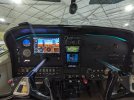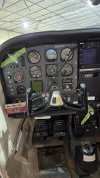AA5Bman
Line Up and Wait
- Joined
- Jun 14, 2009
- Messages
- 821
- Display Name
Display name:
He who ironically no longer flies an AA5B
Okay, rainy day discussion here. I’m in contract to buy a 206. I suspect/hope it will be my forever plane and I’m contemplating just throwing money at it with wild abandon. It’s the plane I’ve wanted literally ever since childhood.
This particular one has nothing in the panel that is worth saving, except perhaps for a single KX155 and associated VOR head, and a JPI700 w/FF.
I don’t fly IFR that much, but I see basic RNAV IFR, auto pilot, and 2x Coms as essential safety equipment (or at least that’s how I’m justifying it), so I’m planning to do a pretty significant panel and autopilot upgrade. Fwiw, I’m agnostic on VORs at this point. I made sure to put one in on the last panel upgrade I did, and hardly - actually never - use it.
There are two buildouts I’m considering. One that will absolutely break the bank and one that I see as merely expensive. I’m curious if you all see other obvious buildouts or ways to save money or get better value.
Option 1 - full panel replacement:
G3X + all engine stuff (computer and sensors for full instrument replacement)
GNX375 - NAV + TX
GTR205 - COM
G5 - required for Autopilot
Possible GNC215 or keep existing KX155
GFC500
GMA345 audio panel
Option 2 - “lower” budget panel upgrade
2x G5s - remove vacuum system, provide head unit for autopilot, and provide display for Nav
GNX375 - Nav+TX
GTR205 - Com
Possible GNC215 or keep KX155.
GFC500
GMA345
- in this buildout would seriously consider upgrading JPI700 to 730.
Here are some thoughts:
- the GFC500 seems like serious overkill for my flying. But are there any 2-axis autopilots that are even worth considering as alternatives? I’ve only ever owned planes with single-axis autopilots and even that would be nice. But if it’s $20k for a knock-off wing leveler and $25k for a GFC, I’m just going to do the full boat GFC500.
- The two buildouts above will be dramatically different in price, and a huge part of the difference is the G3X and Garmin engine monitoring stuff which is way expensive. My primary interest in that buildout, though, is to be able to remove all the original instrumentation so I can be pretty sure I won’t have to chase gremlins later which is so annoying. Is it worth it?
Would love to hear your general thoughts, and if you see any opportunities or options I’m missing. Thanks!
This particular one has nothing in the panel that is worth saving, except perhaps for a single KX155 and associated VOR head, and a JPI700 w/FF.
I don’t fly IFR that much, but I see basic RNAV IFR, auto pilot, and 2x Coms as essential safety equipment (or at least that’s how I’m justifying it), so I’m planning to do a pretty significant panel and autopilot upgrade. Fwiw, I’m agnostic on VORs at this point. I made sure to put one in on the last panel upgrade I did, and hardly - actually never - use it.
There are two buildouts I’m considering. One that will absolutely break the bank and one that I see as merely expensive. I’m curious if you all see other obvious buildouts or ways to save money or get better value.
Option 1 - full panel replacement:
G3X + all engine stuff (computer and sensors for full instrument replacement)
GNX375 - NAV + TX
GTR205 - COM
G5 - required for Autopilot
Possible GNC215 or keep existing KX155
GFC500
GMA345 audio panel
Option 2 - “lower” budget panel upgrade
2x G5s - remove vacuum system, provide head unit for autopilot, and provide display for Nav
GNX375 - Nav+TX
GTR205 - Com
Possible GNC215 or keep KX155.
GFC500
GMA345
- in this buildout would seriously consider upgrading JPI700 to 730.
Here are some thoughts:
- the GFC500 seems like serious overkill for my flying. But are there any 2-axis autopilots that are even worth considering as alternatives? I’ve only ever owned planes with single-axis autopilots and even that would be nice. But if it’s $20k for a knock-off wing leveler and $25k for a GFC, I’m just going to do the full boat GFC500.
- The two buildouts above will be dramatically different in price, and a huge part of the difference is the G3X and Garmin engine monitoring stuff which is way expensive. My primary interest in that buildout, though, is to be able to remove all the original instrumentation so I can be pretty sure I won’t have to chase gremlins later which is so annoying. Is it worth it?
Would love to hear your general thoughts, and if you see any opportunities or options I’m missing. Thanks!






